What is a landfill?
Modern landfills are well-engineered and managed facilities for the disposal of solid waste. Landfills are located, designed, operated and monitored to ensure compliance with federal regulations. They are also designed to protect the environment from contaminants, which may be present in the waste stream. Landfills cannot be built in environmentally-sensitive areas, and they are placed using on-site environmental monitoring systems. These monitoring systems check for any sign of groundwater contamination and for landfill gas, as well as provide additional safeguards. Today’s landfills must meet stringent design, operation and closure requirements established under the Resource Conservation and Recovery Act (RCRA).
Disposing waste in landfills is one part of an integrated waste management system. EPA encourages communities to consider the waste management hierarchy – favoring source reduction to reduce both the volume and toxicity of waste and to increase the useful life of manufactured products – when designing waste management systems.
What types of landfills are there?
Landfills are regulated under RCRA Subtitle D (solid waste) and Subtitle C (hazardous waste) or under the Toxic Substances Control Act (TSCA).
Subtitle D focuses on state and local governments as the primary planning, regulating and implementing entities for the management of nonhazardous solid waste, such as household garbage and nonhazardous industrial solid waste. Subtitle D landfills include the following:
- Municipal Solid Waste Landfills (MSWLFs) – Specifically designed to receive household waste, as well as other types of nonhazardous wastes.
- Bioreactor Landfills – A type of MSWLF that operates to rapidly transform and degrade organic waste.
- Industrial Waste Landfill – Designed to collect commercial and institutional waste (i.e. industrial waste), which is often a significant portion of solid waste, even in small cities and suburbs.
- Construction and Demolition (C&D) Debris Landfill – A type of industrial waste landfill designed exclusively for construction and demolition materials, which consists of the debris generated during the construction, renovation and demolition of buildings, roads and bridges. C&D materials often contain bulky, heavy materials, such as concrete, wood, metals, glass and salvaged building components.
- Coal Combustion Residual (CCR) landfills – An industrial waste landfill used to manage and dispose of coal combustion residuals (CCRs or coal ash). EPA established requirements for the disposal of CCR in landfills and published them in the Federal Register April 17, 2015.
Subtitle C establishes a federal program to manage hazardous wastes from cradle to grave. The objective of the Subtitle C program is to ensure that hazardous waste is handled in a manner that protects human health and the environment. To this end, there are Subtitle C regulations for the generation, transportation and treatment, storage or disposal of hazardous wastes. Subtitle C landfills including the following:
- Hazardous Waste Landfills – Facilities used specifically for the disposal of hazardous waste. These landfills are not used for the disposal of solid waste.
Polychlorinated Biphenyl (PCB) landfills – PCBs are regulated by the Toxic Substances Control Act. While many PCB decontamination processes do not require EPA approval, some do require approval.
